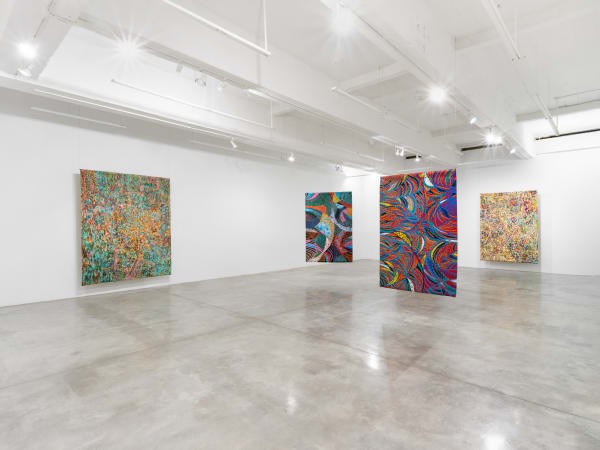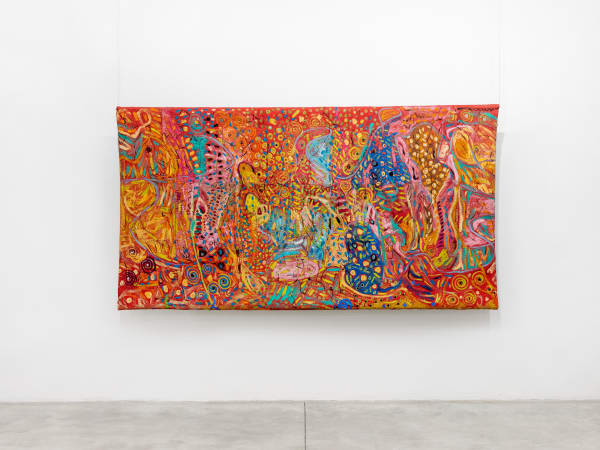Pacita Abad: Colors of My Dream
Tina Kim Gallery is pleased to announce its first major solo exhibition of Pacita Abad (1946-2004), a Filipina-American visual artist. Spotlighting Pacita’s abstract body of work created between 1985 and 2002, this exhibition offers a close look at the development of a vibrant and distinctive style as she pushed the traditional boundary of painting over the course of her 32-year career. Pacita’s oeuvre was informed by her itinerancy and deep engagement with and awareness of issues of globalization, transnationalism, and migration. Incorporating materials and techniques from Manila, Seoul, and Jakarta, the works in this exhibition highlight Pacita’s travels across Southeast Asia. This presentation simultaneously considers her use of color and material ornamentation as a strategy of resistance against the homogenizing modernist paradigm, while forging a transcultural solidarity.
Born in Batanes, Philippines to politically engaged parents, Pacita Abad settled in the US in the 1970s, forced to flee after leading student demonstrations against the Marcos regime, subsequently beginning what would be a prolific artistic career. Pacita innovated a form of textile-painting called trapunto—she painted, stitched, padded, and embellished unstretched canvases to create a dimensional object with expanded surface and portability, allowing for fluid and spontaneous artistic experimentation. Her trapuntos translate lived experience by incorporating indigenous materials, ranging from Rabari mirrored embroidery from India, bark cloth from Papua New Guinea, huipils from Guatemala and Mexico, and batik and ikat from Indonesia, forming what Stanka Radovic terms “a living tapestry of places.” Pacita Abad lived on six continents and traveled to over sixty countries, which led to the encounter and absorption of global textile traditions and techniques.
Pacita’s early foray into abstraction began in the mid 1980s, when she returned to live in Manila after a twelve-year leave. Sampaloc Walls (1985), a seminal work that refers to peeling paint on the walls of downtown Manila, engages with the socio-political context of the locale—the city walls bare and painted white as part of Marcos’ authoritarian self-legitimizing campaign. The work formally and narratively links to Palengke (1986), adorned with glittering mirrors and buttons. It recalls the sensory experience of strolling through Divisoria, the sprawling public market where Pacita and her family bought fabric and textiles. The method of stitching and padding the canvas further enhances the undulating effect that alludes to the constant circulation of commodities, goods, and people.
Pacita Abad learned textile-based skills such as sewing, crocheting, embroidering, and lacemaking at a young age from her mother while growing up in Manila with her eleven siblings. It was while living in Boston in 1981 that she was introduced to the trapunto by her friend Barbara Newman, a doll-maker, and continued to explore and transform this technique. From 1983 to 1992, Pacita’s first series of large abstract paintings called “Asian Abstractions” took inspiration from Korean ink brush painting that she briefly studied in Seoul in 1983. The original rice stalk design is developed into a silkscreen print, migrated to the top canvas, delineated with running stitches, and enhanced through the gradual addition of colors. The back of the works reveal a constellation of intricate patterns that echo the front, centering handicraft as creative labor and revealing Pacita’s structural experimentation.
Pacita’s vigorous fusion of paint, material embellishment, and color are on full display in her later abstractions. Moving from the United States to Indonesia in 1993 in search of a renewed sense of color, Pacita became fascinated with Indonesian textiles and other indigenous art forms like the Wayang puppetry. In Bandung (1999), a polyphony of colors and patterns unfurl across the surface as Pacita worked to subsume the Indonesian batik fabrics into the painted lattices, coalescing into a mass of pulsating energy. The title contains a dual reference to the Bandung Conference of 1955, when representatives from twenty-nine governments of Asian and African nations gathered in Bandung, Indonesia to discuss peace and the role of the Third World in a time of decolonization. Arguably among her most personal and reflective, “Endless Blues” series comprises the final large-scale paintings by Pacita, during a period of heightened emotion and creativity following her cancer diagnosis and the aftermath of 9/11. Highly expressive while paying homage to Blues music, these works embody both introspection and refusal to retreat into silence.
While Pacita’s propensity to take her paintings into the realm of social inquiry may be most evident in figurative works like the “Immigrant Experience” and “Masks and Spirits” series, her “tropical aesthetic” and ornamental lexicon serve to activate the political possibility of abstraction. As a woman of color whose life was often in transit but whose vision was global, Pacita cannot be easily balkanized into a singular category. In Fresh Talk/Daring Gaze, Faith Ringgold points out that Pacita’s sense of coloration augments the visibility of both her work and person and relates it to the experience of sexism and racism faced by the racial others. Viewed through such lens, color is the thread that connects the various cultural, economic, and historical peripherals and a way of standing with diasporic or marginalized communities. Pacita’s abstractions transmute cultural specificity into collectivity, inverting the mechanics of marginalization while carving out a new space in which cultures, identities, and materialities may intersect and form new meanings.
Including paintings from important private collections as well as from the Pacita Abad Art Estate, this solo presentation will be one of the first in New York City devoted to Abad in over twenty years. The exhibition takes place concurrently with a major traveling retrospective at the Walker Art Center in Minneapolis, curated by Victoria Sung with assistance from Matthew Villar Miranda. The retrospective will travel to San Francisco Museum of Modern Art; Art Gallery of Ontario, Toronto; and MoMA PS1, New York. Abad’s works are in the permanent collection of Tate Modern, M+ Hong Kong, National Gallery Singapore, National Museum of Women in the Arts, Walker Art Center, and major institutions around the world.
ABOUT THE ARTIST
Born to a family of politicians and activists in Batanes, the furthermost-north island state in the Philippines, Pacita Abad (1946-2004) made a brief stop in the US en route to Spain to finish her graduate studies after political violence initiated by Ferdinand Marcos put her life in danger. Abad decided to settle in San Francisco in 1970 and met her husband Jack Garrity a few years later, embarking on what would be an itinerant, global life together. Abad obtained an MA in Asian History from the University of San Francisco in 1972 and studied painting at the Corcoran School of Art in Washington, D.C. in 1975 and the Arts Student League in New York in 1977.
Pacita’s oeuvre featured an immense array of subject matter, from tribal masks and social realist tableaus to lush and intricately rendered underwater scenes and abstractions, predating contemporary discourses around postcolonial feminisms, globalization, and transnationalism. She has had solo exhibitions at the Jameel Arts Center, Dubai (2021); Spike Island, Bristol (2020); the Museum of Contemporary Art and Design, Manila (2018); Cultural Center of the Philippines, Manila (2004); National Museum, Jakarta (1998); the National Museum for Women in the Arts, Washington, D.C. (1994); Hong Kong Arts Centre (1986); and the Bhirasri Museum of Modern Art, Bangkok (1980), among many others.
Her work has been featured in notable exhibitions, including the 11th Berlin Biennial; 13th Gwangju Biennial; 4th Kathmandu Triennial; Asia/America: Identities in Contemporary Asian American Art, a traveling exhibition organized by the Asia Society, New York; Beyond the Border: Art by Recent Immigrants, Bronx Museum of the Arts, New York; La Segunda Bienal de la Habana, Cuba; and Second Contemporary Asian Art Show, Fukuoka Art Museum, Japan. Her work can be found in the collections of Tate Modern, London; the National Museum of Women in the Arts, Washington, D.C.; M+ Museum, Hong Kong; and the National Gallery Singapore. She passed away in Singapore in 2004.
Pacita Abad is the subject of a major traveling retrospective at the Walker Arts Center in 2023 in Minneapolis, curated by Victoria Sung with assistance from Matthew Villar Miranda. It will travel to San Francisco Museum of Modern Art; Art Gallery of Ontario, Toronto; and MoMA PS1, New York.
ABOUT THE GALLERY
Founded in New York in 2001 by Tina Kim and located in Chelsea, Tina Kim Gallery is celebrated for its unique programming that emphasizes international contemporary artists, historical overviews, and independently curated shows. With the gallery’s strong focus on Asian contemporary artists, Tina Kim has become a leading figure in introducing the Korean Dansaekhwa art movement to the American audience. Furthermore, she has created a platform for emerging and established artists such as Lee Seung Jio, Pacita Abad, Kim Tschang-Yeul, Tania Pérez Córdova, Minouk Lim, Davide Balliano, and Suki Seokyeong Kang. Through its programming, the gallery works closely with internationally renowned curators for special exhibitions and produces scholarly art publications.
SALE INQUIRIES
inquiries@tinakimgallery.com
+1 (212) 716-1100
Ami Yang | Associate Director
ami@tinakimgallery.com
+1 (212) 716-1100
PRESS INQUIRIES
Diana Lee | Media & Artist Relations
diana@tinakimgallery.com
+1 (212) 716-1100
Jillian Scott | Third Eye
jillian@hellothirdeye.com
+1 (212) 355-9009 x 313
-

Pacita Abad: Dreams in color
Inquirer.net May 22, 2023NEW YORK — I don’t remember exactly where I first met the artist Pacita Abad, whether in New York, Washington, or in Manila, nor the...Learn More -

Six Gallery Shows to Catch in Chelsea After Frieze
ARTnews May 17, 2023Pacita Abad at Tina Kim Gallery For those unfamiliar with the prolific practice of the late Pacita Abad, this lush solo show at Tina Kim...Learn More



